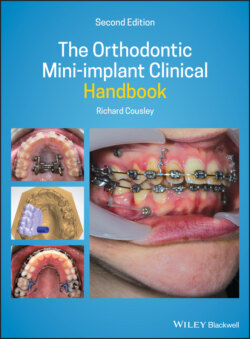Читать книгу The Orthodontic Mini-implant Clinical Handbook - Richard Cousley - Страница 21
1.8 Mini‐implant Success and Failure
ОглавлениеFailure of a mini‐implant is the ‘risk’ that one ought to focus on most in day‐to‐day clinical terms. Mini‐implant failure means that it cannot be used for its intended clinical loading/anchorage purposes. Conversely, mini‐implant success is generally defined as the fixture remaining stable under continuous orthodontic loading for a minimum period of six months, although many studies have used one year as the minimum observation time. One of the most recent overviews of success rates has been provided by a meta‐analysis of 3250 mini‐implants, which showed a combined rate of 86% [16]. When the effect of insertion site is analysed, there is a consensus in the literature that the success rate varies according to the jaw involved, at approximately 80% and 90% for alveolar sites in the mandible and maxilla respectively, and up to 99% in the midpalate [17–30]. Conversely, success rates for infrazygomatic sites are relatively low, at 78%, as reported in a study of 30 consecutive Caucasian patients [31]. This may seem counterintuitive since the mandible is generally regarded as the stronger jaw bone, but the reasons for this paradox will be explained in Chapter 2.
Interestingly, mini‐implants with minor mobility may still be graded as successful. This is evident clinically by slight rotational or lateral movement of the mini‐implant on manipulation. This is painless and consequently asymptomatic for the patient. It is easily resolved by tightening the mini‐implant, usually by a clockwise turn (insertional rotation), provided that this does not submerge the head, and without the need for anaesthesia. Notably, for Infinitas mini‐implants, one complete turn equates to 0.7 mm further insertion. However, if the mini‐implant displays obvious lateral mobility with light digital pressure then this indicates failure and the mini‐implant should be removed.
Fortunately, most mini‐implant failures become clinically evident within the first few months of insertion [20,24,25], enabling early replacement or a modification to the treatment plan. However, it important to realise that replacement mini‐implants still have much lower success rates than primary insertions [32,33]. For example, a recent study of 471 mini‐implants showed primary and secondary (replacement) success rates of 85% and 58% for maxillary buccal sites and 79% and 77% respectively for midpalate sites [33]. This marked drop in success rates for buccal, but not palatal, insertion sites suggests that the midpalate ought to be considered if a maxillary buccal mini‐implant fails unless there has been an obvious and rectifiable explanation for the failure. Therefore, it is important to determine the likely reason for failure and undertake remedial clinical steps, such as root divergence, to favourably alter the chances of success for a secondary buccal site insertion. On the plus side, when a mini‐implant feels firm after two months in situ then normal orthodontic forces may be applied with confidence.
Mini‐implant failures are staged according to the time taken for this to manifest after insertion.
Primary failure occurs when a mini‐implant is clinically mobile at the time of insertion. This is due to inadequate cortical bone support in terms of its thickness and density, or close mini‐implant proximity to an adjacent tooth root or incorrect insertion technique. These factors will be fully discussed in the relevant sections.
Secondary failure refers to a situation where the mini‐implant is initially stable but then exhibits mobility, usually after 1–2 months. This delayed instability is due to bone necrosis around the mini‐implant threads, which may result from thermal bone damage (during pilot drilling), excessive insertion torque, excessively close proximity to a tooth root, traction overload, or a combination of these.
Most mini‐implant failures become clinically evident within the first few months of insertion, enabling early replacement.
